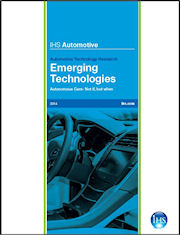Self-driving cars (SDCs) are coming. Will Virginia government, law and transportation planning keep up? There’s sign no of it. Indeed, the Old Dominion could experience a transportation crack-up in 15 to 20 years if we don’t start preparing now.
There’s no excuse for not thinking ahead. A new study by the IHS Automotive market research firm provides a timetable of what to expect.
“Autonomous” cars, which take over limited driving functions from drivers such as cruise control and lane-keep assist, are already on the road. Rather than leaping into fully self-driving cars, automobile manufacturers are adding more autonomous features with each passing year. The National Highway Safety Administration (NHTSA) rates automobiles’ autonomy from Level One to Level Five, in which cars assume greater control at higher levels. Level Four vehicles allow drivers to assume control, if they desire. Level Five do it all — drivers just plug in the destination.
Several automobile manufacturers have declared that they will sell autonomous cars by 2020, if not earlier. In IHS’s estimation, these cars will be only Level Three vehicles, providing significant auto-pilot features but still requiring driver involvement. However, Level Four cars will be introduced to the market by 2025, and Level Five cars by 2030. Due to the length of time it takes for old cars to phase out of the automobile fleet, it will take several years more before Self Driving Cars (SDCs) actually dominate the roads.
With North America leading the way, worldwide sales of SDCs will grow from 230,000 in 2025 to 11.8 million in 2035. Truly driverless cars (Level 5) will enter the market in 2030 with about 240,000 sales, growing to 4.8 million in 2035. In the early years, the percentage of SDCs on the road will be very small. But with turnover in the automobile fleet, the percentage will grow steadily.

The Mercedes concept car of the future: body of carbon fiber, powered by hydrogen fuel cell… and self-driving.
Cost will be a significant barrier. The price premium for SDC electronics technology will add between $7,000 and $10,000 to a car’s sticker price by 2025. As Level Five vehicles are introduced, however, the premium will drop to $3,000 because driver controls can be eliminated. Offsetting that price will be the compelling advantage of increased safety. Driverless cars will experience fewer accidents, and those will come mainly from tangling with human drivers. As the roads come to be dominated by driverless cars, IHS predicts (perhaps optimistically) that accidents will approach zero.
There will be other advantages, such as the ability for driverless cars to “platoon” on highways, driving safely at high speeds in tighter formations, thus increasing highway capacity. Driverless cars will allow the elderly to maintain their personal independence later into life. Affluent parents can be liberated from the tedium of driving their children everywhere. (IHS doesn’t mention this but, if drunks can let their cars drive them home, driverless cars could spark a rebirth of partying!)
IHC sees two major technical barriers that the automobile industry will have to resolve. One is software reliability. Automobiles will contain millions of lines of code that will be impossible to test under all circumstances. Mishaps will happen. It’s one thing when a PC crashes, it’s quite another when a car crashes. The second issue is cyber security. There is a risk that cars can be hacked. Some futurists are already speculating how a hacker could sabotage a driverless car in order to kill the occupants.
The other barrier is the legal and regulatory structure. The number one issue: Who is liable when something goes wrong? Do you blame the driver/owner or the automobile manufacturer? The evolution of tort law pertaining to driverless cars can have a big impact on how rapidly they are adapted in a particular state.
There are public policy issues as well. In theory, platooning will increase the capacity of Virginia highways, relieving the need to spend billions of dollars in highway widening projects. That will be a boon a half century from now when every car on the road is an SDC. But the transition could get tricky. Can platoons of fast-moving, tightly packed vehicles share the roads with ordinary cars? Should Virginia privilege autonomous cars by creating SDC-only lanes?
We also need to re-think traffic forecasts. As I’ve argued repeatedly, Virginia’s traffic forecasts consist mostly of straight-line projections of past trends and don’t account for changing demographics and the increasing preference for walkable communities and mass transit. But driverless cars could scramble the equation. If such cars could drive faster in platoons, if drivers could spend their time reading the news, emailing friends, watching movies — or catching up on their sleep — then an hour-long drive to work would become more tolerable. If driverless cars revitalize the long-distance commute, what will happen to the demand for mass transit? What will happen to the relative demand for real estate in the urban core and on the metropolitan periphery? Will we see a reversal of America’s urban renaissance? Planners, urbanists and smart-growth thinkers haven’t begun to grapple with these questions.
I see driverless cars as a significant net gain for American society. But there are potential pitfalls and we have to anticipate them. In the meantime, I would urge public officials to anticipate the impact of driverless cars when allocating transportation dollars. The last thing we need to do is to sink money into transportation assets that will become outmoded in 20 to 30 years. Driverless cars will be here long before the financing bonds are paid off.



